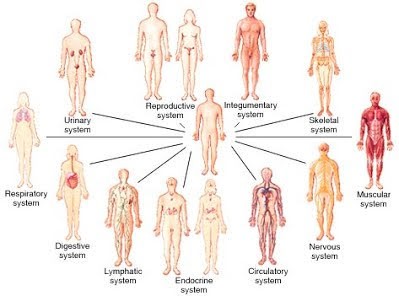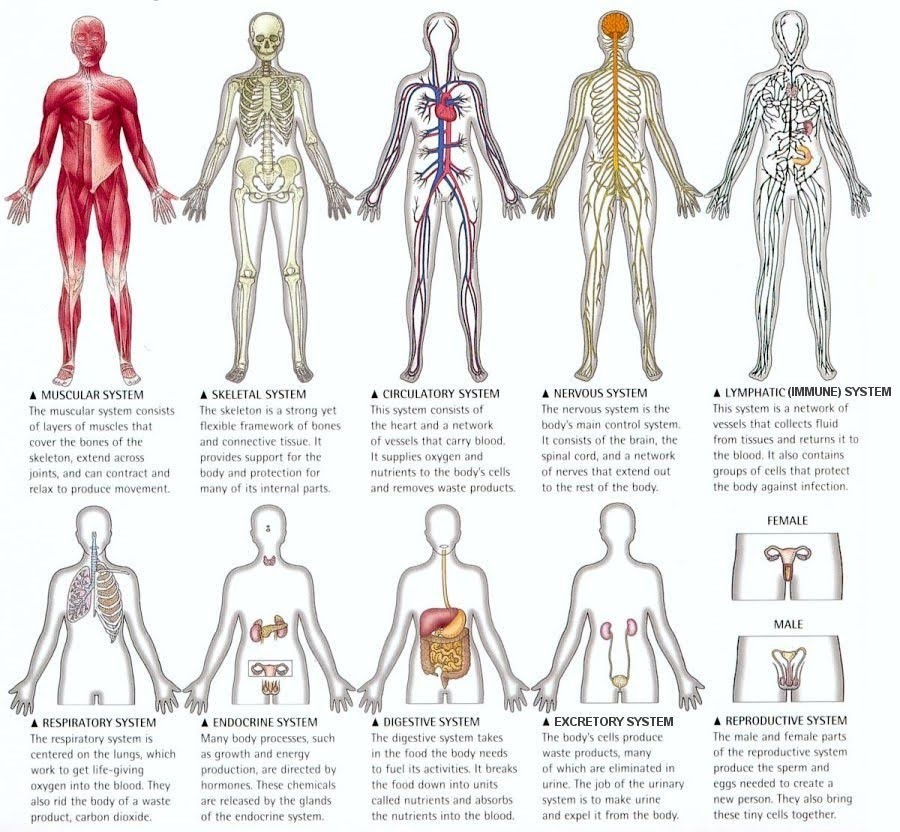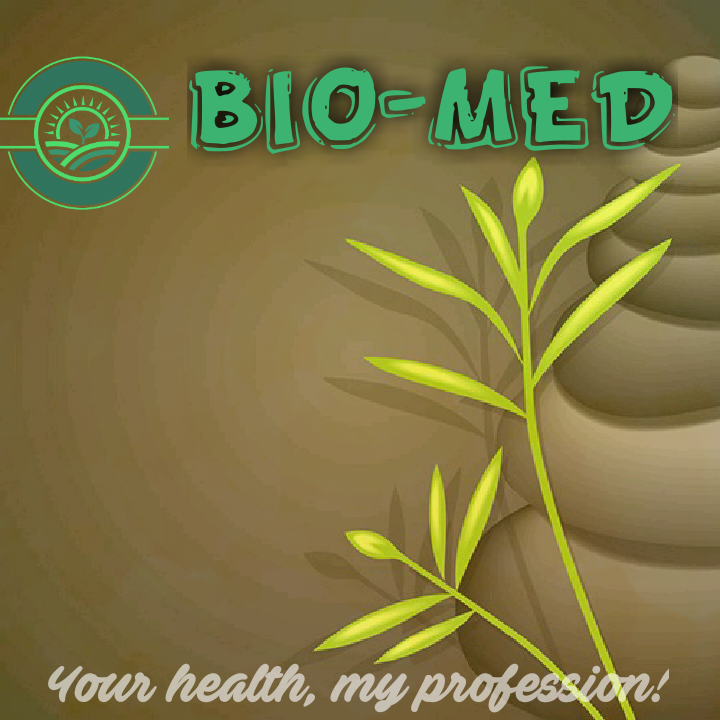Anatomy is defined as the science which deals with the structural organization of a living being. It is the science that studies the structure of living organisms. The word anatomy is derived from a Greek word, anatome which means to cut off. It is Latin equivalent meaning is dissection.
Hence, human anatomy is the science that deals with the study of the structure of the human body; internal and external. Human anatomy spans over the study of the entire human body; internationally accepted nomenclature of anatomical positions of organs, tissues, bones, connective tissues as well as ligaments.
Anatomically, the body is divided into three imaginary planes. These planes aid doctors and medical students in a thorough study and viewing of the body parts. They are:
- Sagittal Plane (also called the midline of the body): This plane divides the body into the left (Latin word: sinister) and right (Latin word: dexter) sides of the body. It is the most used plane in the study of human anatomy. The sagittal plane divides the body such that the paired parts of the body (hands, eyes, feet, ears, mammary glands, etc) are seen on both the left and right sides while the unpaired parts (nose, mouth, genital organs, face, etc) are equally divided into two equal parts, hence its importance in the study of human anatomy.
- Transverse Plane: This divides the body superiorly and inferiorly (up and down), which gives rise to the proximal or cranial parts (towards the head region) and distal or caudal parts (away from the head region) of the body.
- Frontal Plane: This plane divides the body into the anterior (front) and posterior (back) portions of the body.
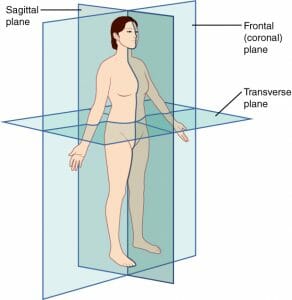
Anatomical Position Of The Body
This is simply how the human body specimen is positioned during an anatomical study. It is the description of any region or part of the body in a specific stance. In the anatomical position, the body is upright (chin up, head facing forward and held high, shoulders straight chest out, feet in the correct standing posture), directly facing the observer, feet flat and directed forward. The upper limbs are at the sides of the body with the palms facing forward.

If the anatomical position is placed face-down, it is in the prone position but if the anatomical position is placed face-up, it is in the supine position.
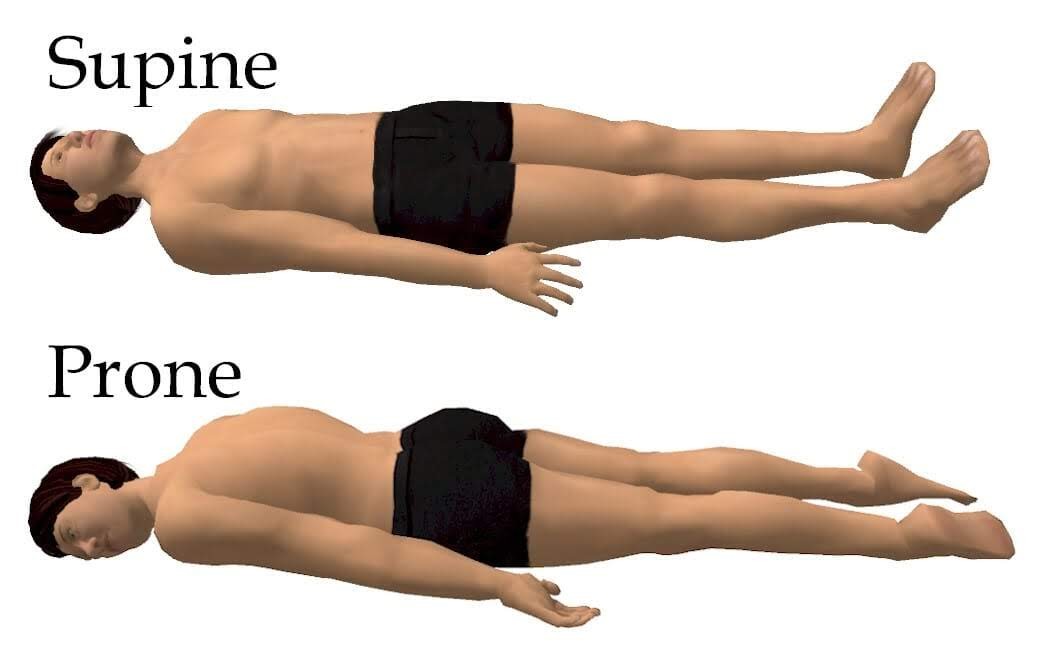
Anatomical Directional Terms Of The Body
Basically, there are twelve anatomical positions:
- Superior (Cranial): Towards the upper part of the body. Example: the neck is superior to the shoulder. (N.B: The part of the body doesn’t necessarily have to be on the cranium to be superior to another part of the body in comparison. As long as that part of the body is more proximal to the cranium than the other, then it is superior to the other).
- Inferior (Caudal): Away from the upper part (cranial region) or towards the lower part (caudal region) of the body. Example: the navel is inferior to the chin; the mandible is inferior to the maxillae.
- Anterior (also known as ventral): In front of or at the front of the body. Example: the sternum (breast bone) is anterior to the spine; the nose is anterior to the ears.
- Posterior (also known as dorsal): Behind or at the back of the body. Example: the vertebral column is posterior to the ribcage.
- Medial: Towards the midline (or sagittal plane) of the body. Example: the sternum is medial to the upper limbs.
- Lateral: Away from the midline of the body. Example: the upper limbs are lateral to the sternum.
- Proximal: Closer to an organ in relation to another body part. Example: the ankle is proximal to the tarsals.
- Distal: Away from, in relation to another body part. Example: the arms are distal to the metatarsals.
- Superficial: Internally situated but projects towards the surface of the body. Example: the veins are superficially rooted in the body.
- Deep: More internally situated. Example: the arteries are deeply rooted in the body.
- Ipsilateral: Located on the same side of the body. Example: the left hand and the left foot are ipsilateral.
- Contralateral: Located on opposite sides of the body. Example: the right hand and the left foot are contralateral.
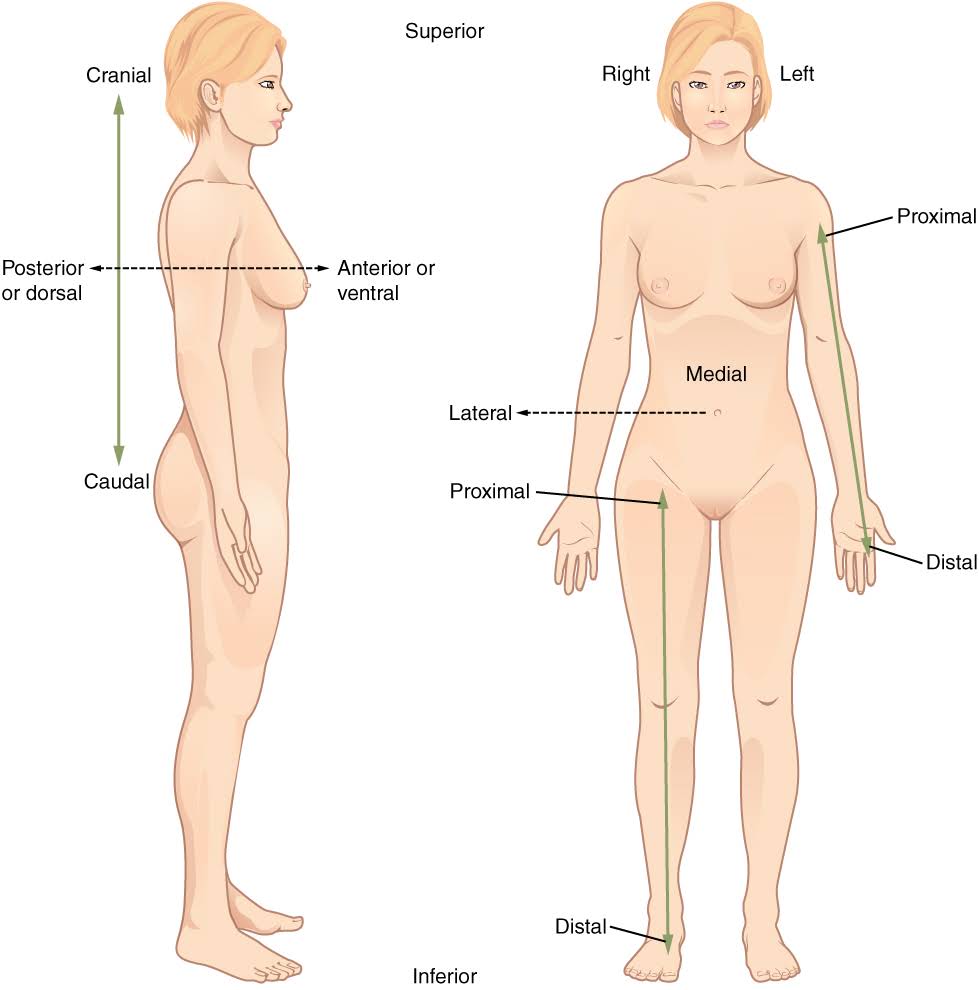
Anatomical Regions Of The Body
For easy understanding, the anatomical regions of the body will be treated from two different views: the ventral (frontal/anterior) view and the dorsal (back/posterior) view.
Ventral (Anterior) View:
Cranial Region: The region which encompasses the upper part of the head, wherein the brain is located.
Cephalic or Facial Region: The region which encompasses the lower half of the head, beginning below the ears. This region houses:
- The forehead which is referred to as the frontal region
- The eyes and its sockets which is referred to as the orbital region
- The nose and the entire nasal cavity which is referred to as the nasal region
- The mouth and the entire oral cavity which is referred to as the oral region
- The cheek which is referred to as the buccal region
- The jaw or chin which is referred to as the mental region.
Cervical Region: This region encompasses the neck area. The name is given due to the seven cervical vertebrae in the human body.
Thoracic Region: This encompasses the entire chest region (rib cage). Its name is gotten from the twelve thoracic vertebrae located at its posterior portion. It houses:
- Sternal Region: This is the region wherein the sternum (breast bone) is situated.
- Axillary Region: This is the area around the side of the ribs.
- Mammary Region: This is the region around the breast (which is more prominent in adult females than in the male counterparts as well as the younger females).
Region of the Upper Limb: The upper limb here refers to the entire arm starting from the shoulder blade. It houses:
- Acromial Region: This is where the bones of the shoulder are situated, which is the clavicle and the acromion. The glenoid cavity where the head of the humerus fits into the scapular can be viewed anterolaterally in this region.
- Brachial Region: This encompasses the entire arm which also consists of the antebrachial region which is the forearm and the antecubital region which is the front elbow.
- Carpals Region: This refers to the wrists.
Manus Region: This is simply the area around the hands. Its ventral view comprises of the:
- Pollex Region: This refers to the thumb.
- Palmar Region: This is the area where the palm is situated.
- Digital Region: This is where the fingers (phalanges) are located.
Abdominal Region: This region encompasses the stomach area. It consists of:
- The Umbilical Region which is the center of the abdomen where the navel is situated.
- The Inguinal Region encompassing the groin area.
Pelvic Region: This is the region where the hip bone is situated.
The Pubic Region which is the area above the male and female genitals.
The Lower Limb Region: This is the entire starting from the region the point of articulation between the head of the femur and the pelvic girdle and extends down to the feet and the digitals (the toes). This region comprises of:
- The Coxal Region encompassing the beltline, hence situated at the waist and extends to the hip.
- The Femoral Region: This area begins from the point of articulation between the head of the femur (thigh bone which is the longest bone of the body) and extends down to the point of articulation between the femur and the tibia.
- The Patellar Region: This simply refers to the patella (also known as the knee bone).
- The Crural Region: This is the region where the legs are situated.
- The Fibular or Peroneal Region: This is the region where the tibia and fibula are located.
The Pedal Region: This is the region where the foot bones are located. It comprises of:
- The Tarsal: These are bones that form the form and the heel of the feet.
- The Metatarsals: These are the bones of the feet, but can be better identified through the ventral view.
- The Digitals: Another name for these bones is phalanges (including the digitals of the carpals i.e the fingers).
Dorsal (Posterior) View:
Cranial Region: This is the region behind the cranium. It comprises:
- The Otic or Auricle Region which is where the ear is situated.
- The Occipital Region: This is the region surrounding the base of the skull.
Cervical Region: When cut open, the seven cervical vertebrae and their point of articulation can be seen.
The Dorsal (Dorsum) Region: This is the parallel region located behind the body, which comprises:
- The Vertebra Column: This houses the spinal cord and consists of the thoracic, lumbar and sacral (the back pelvic bone).
- The Gluteal Region: This is where the buttocks (the storage site of adipose tissue) is located.
- The Perineal Region: This is the area between the anus and external genitals.
The Upper Limb: From the dorsal view of the upper limb, the following can be identified:
- Olecranal Region: This is the area where the elbow is situated.
- Posterior Brachial Region: This is simply the back of the arm. It also consists of the posterior antebrachial region which is the back of the forearm.
- The Acromion (Scapula): The flat posterior portion of the shoulder blade.
The Manus (hands): The posterior part of the manus which shows the posterior part of the metacarpals, carpals, and phalanges.
The Region of the Lower Limbs: The dorsal view of this region shows:
- The Femoral Region which is the posterior part of the thigh.
- The Popliteal Region which is the region surrounding the back of the knee bone (patella).
- The Sural Calf: This is the posterior area below the knee.
- The Fibular (Peroneal) Region which is the posterior portion of the lower leg.
The Pedal (Foot) Region: This is the portion of the feet that is always in direct contact with the ground. The weight of the body is usually directed to this region, hence its large size. It comprises of:
- The Calcaneal which is the heel bone.
- The Plantar Region: This is simply the sole of the feet.
- The Hallux Region: This is the area under the toes.
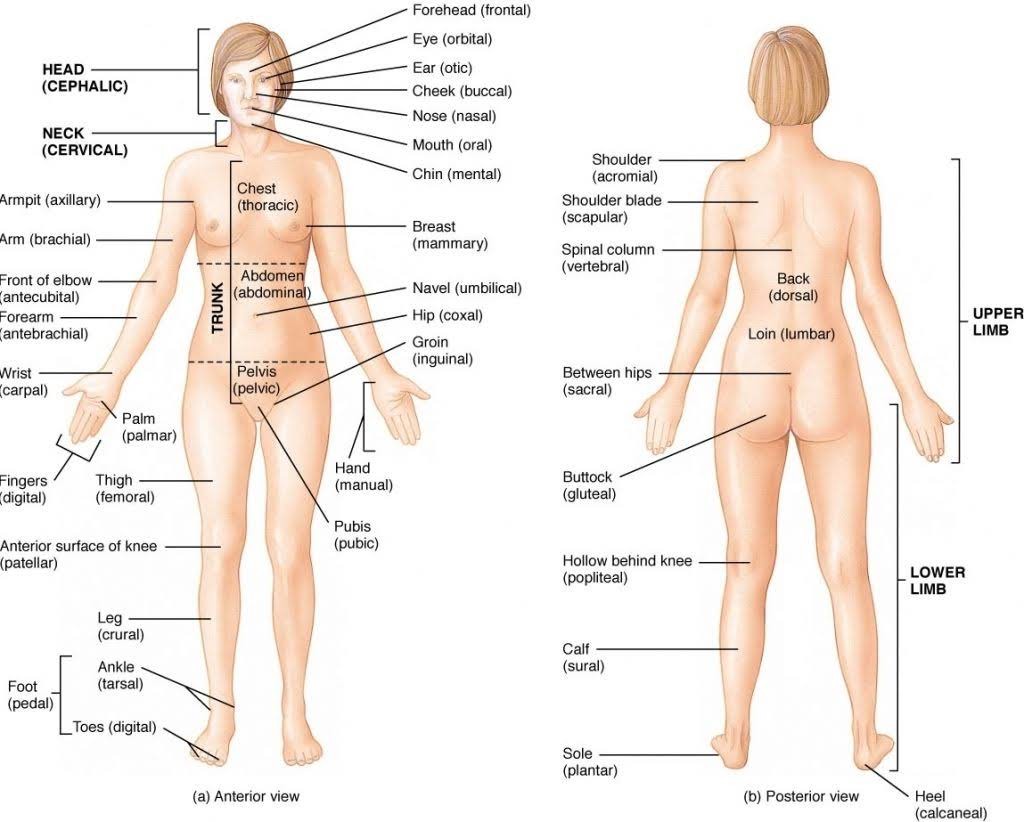
Body Cavities:
A body cavity is any compartment or potential space in the body of a living organism. Cavities houses organs especially the delicate organs of the body and other structures; cavities as potential spaces contain a fluid that provides a liquid nutrient medium for the organs enclosed in them.
The two largest human body cavities are the ventral body cavity and the dorsal body cavity.
The Dorsal Body Cavity: It is subdivided into the cranial cavity which houses the brain enclosed in a skull or cranial box and a vertebral cavity that runs through the vertebral column and houses the spinal cord.
The Ventral Body Cavity: This cavity contains the majority of the body organs such as lungs, heart, intestines, kidneys, etc. These organs are called visceral organs or viscera. The ventral body cavity has two main divisions: the thoracic cavity and the inferior abdominopelvic cavity. These two body cavities are separated by the diaphragm (a dome-shaped muscle used for breathing). The thoracic cavity is surrounded by the muscles of the chest wall and the ribs while the inferior abdominopelvic cavity is surrounded by the abdominal walls and pelvic girdle respectively.
The thoracic cavity has two parts: two lateral parts each containing a lung surrounded by a pleural cavity; a central band of organs called mediastinum which contains the heart (surrounded by the pericardial cavity). It also houses other thoracic organs such as the esophagus, tracheae, etc.
The abdominopelvic cavity is also divided into two parts namely: the superior part called the abdominal cavity which houses the liver, stomach, kidney and the inferior part called the pelvic cavity which houses the bladder, some reproductive organs, and the rectum. These two cavities of the ventral body cavity are not separated by any muscle or membranous partity. Many organs in the abdominopelvic cavity are surrounded by a peritoneal cavity.
Serous Cavity lined by the serous membrane or serosa surrounds the abdominopelvic cavity. The serous membranes are named pleura, pericardium, and peritoneum respectively. The parietal serosa is continuous with the visceral serosa which lines the visceral organs. Serous cavities, however, contain a serous fluid that aids in the movement of some organs like churning stomach, pumping heart, etc thus preventing friction.
Other body cavities (most of which are found in the cephalic region) includes:
- Oral Cavity: It is the opening of the digestive system which starts at the mouth, contains the tongue, teeth and opens exteriorly at the anus.
- Nasal Cavity: Contains the nasal bones and conchae, starts the respiratory passage of the respiratory system.
- Middle Ear Cavity: Situated medial to the eardrum and houses the ear ossicles.
- Orbital Cavity: This houses the eye, its sockets, and produces it to an anterior portion.
- Synovial Cavity: This is the space that surrounds freely moveable joints and secretes a synovial fluid that lubricates the joint to avoid friction.
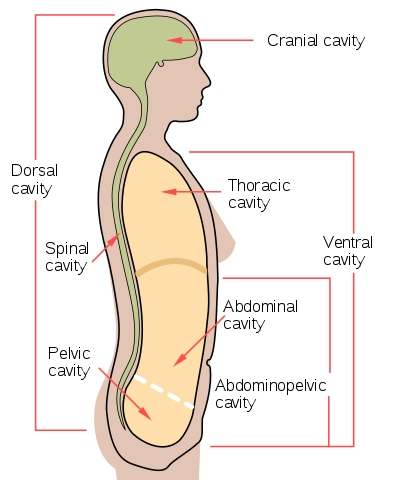
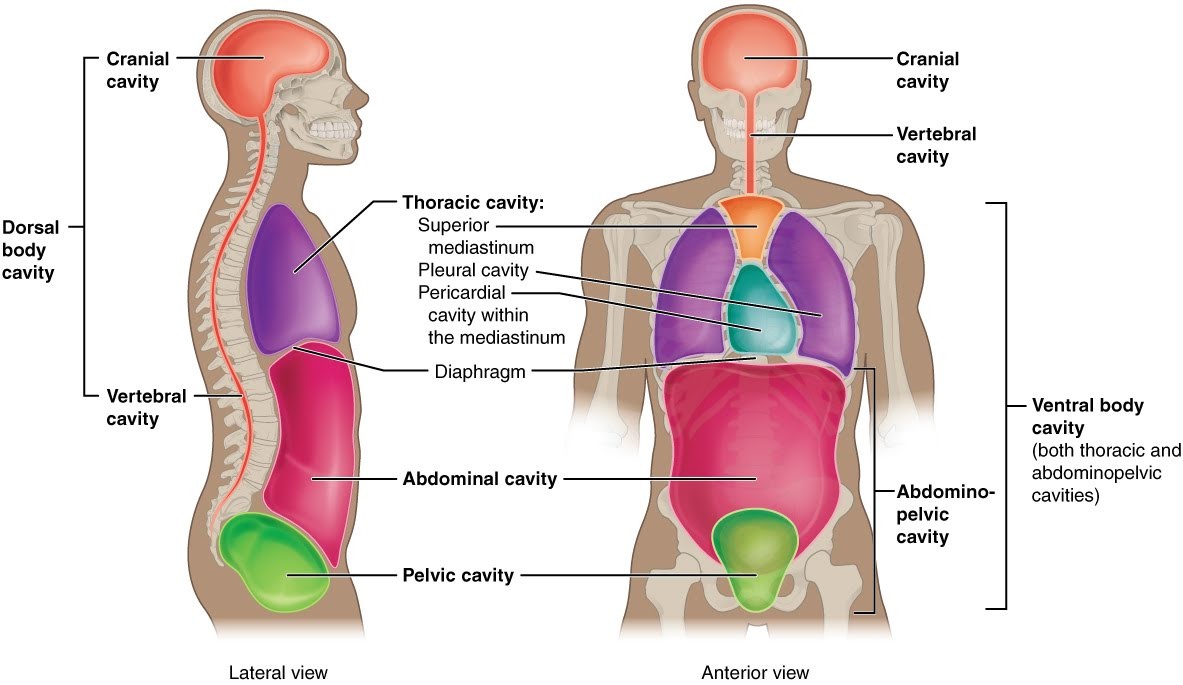
Abdominal Regions and Quadrants:
Due to the complexity of the organs in the abdominal region, this region is thus divided into nine sub-regions with two transverse planes and two parasagittal planes. They include:
- Right hypochondriac region
- Left hypochondriac region
- Epigastric region
- Right lumbar region
- Left lumbar region
- Umbilical region
- Right (iliac) inguinal region
- Left (iliac) inguinal region
- Hypogastric region
However, for localizing organs in a more general way, the abdominal region was hence divided into four quadrants:
- Right Upper Quadrant
- Right Lower Quadrant
- Left Upper Quadrant
- Left Lower Quadrant
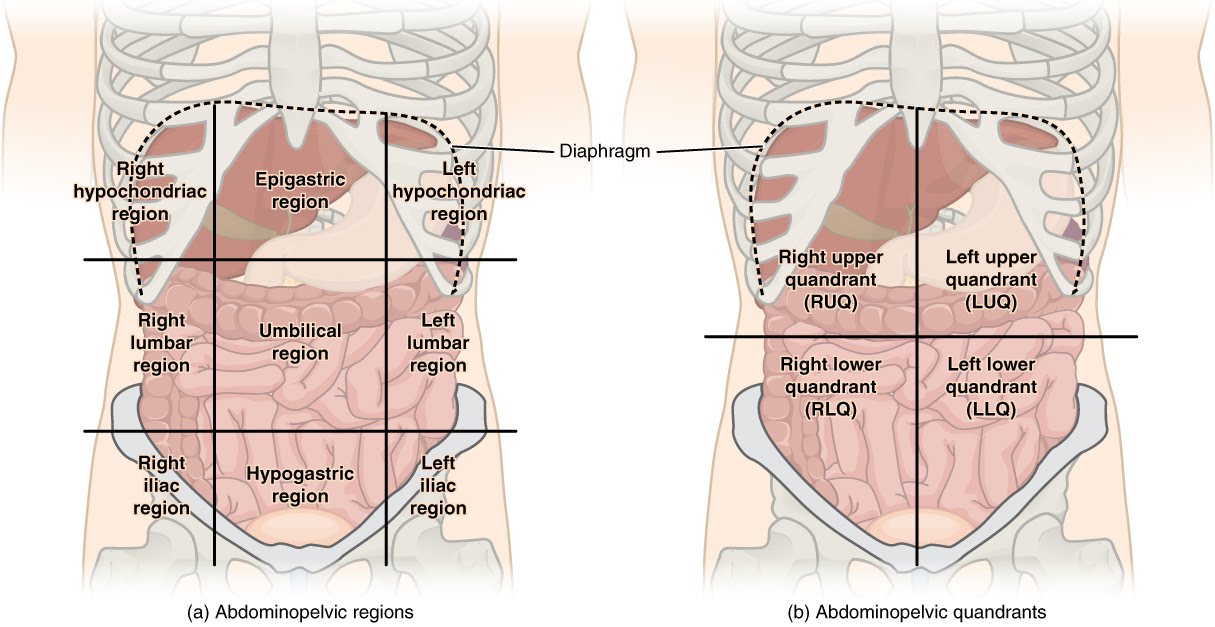
SUMMARY OF THE BODY’S ORGANS AND SYSTEMS
Integumentary System: It consists of hair, skin, nails. It is the site of cutaneous receptors, sweat and oil glands.
Skeletal System: Skeletons. It is the bony framework of the body which provides rigidity and support. It serves as protection to the delicate organs of the body as well as a site for the production of red blood cells (bone marrow of long tubular bones).
Muscular System: It consists of muscles. It is used in locomotion, facial expression, etc.
Nervous System: It is made up of the brain, spinal cord, nerves, sensory receptors. These organs transmit nerve impulses and their results are usually short-timed and very rapid.
Endocrine System: It is made up of ductless glands that secrete chemical substances called hormones that regulate body processes.
Cardiovascular System: It consists of the heart and blood vessels. They transport blood and nutrients to various parts of the body, excretes wastes and circulate blood throughout the body.
Lymphatic System: It is made up of the lymph and lymph nodes. They filter wastes. house the lymphocytes (WBC) which provides immunity and body defense against foreign bodies in the human body.
Respiratory System: It comprises various parts of the body. It starts at the nasal cavity as air is inhaled and exhaled through the same opening. Keeps blood supplied with O2 and removes the CO2 through the lungs.
Urinary System: It comprises of the kidneys, urethra, the bladder, and the male and female excretory organs. It eliminates nitrogenous wastes in the form of urea through the kidneys, regulates water, electrolytes, and pH of the body.
Reproductive System: It comprises various organs of the human body. It is used for procreation and continuity of species.
